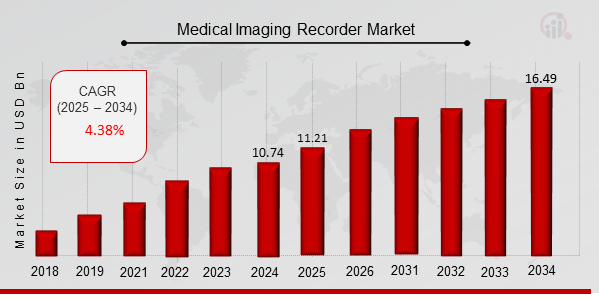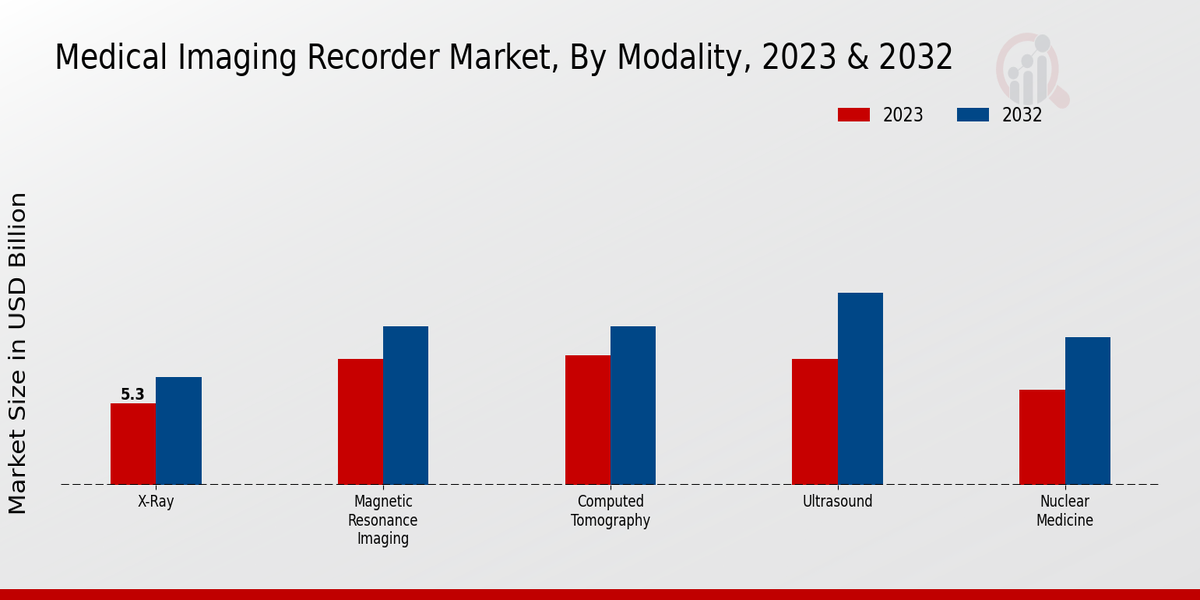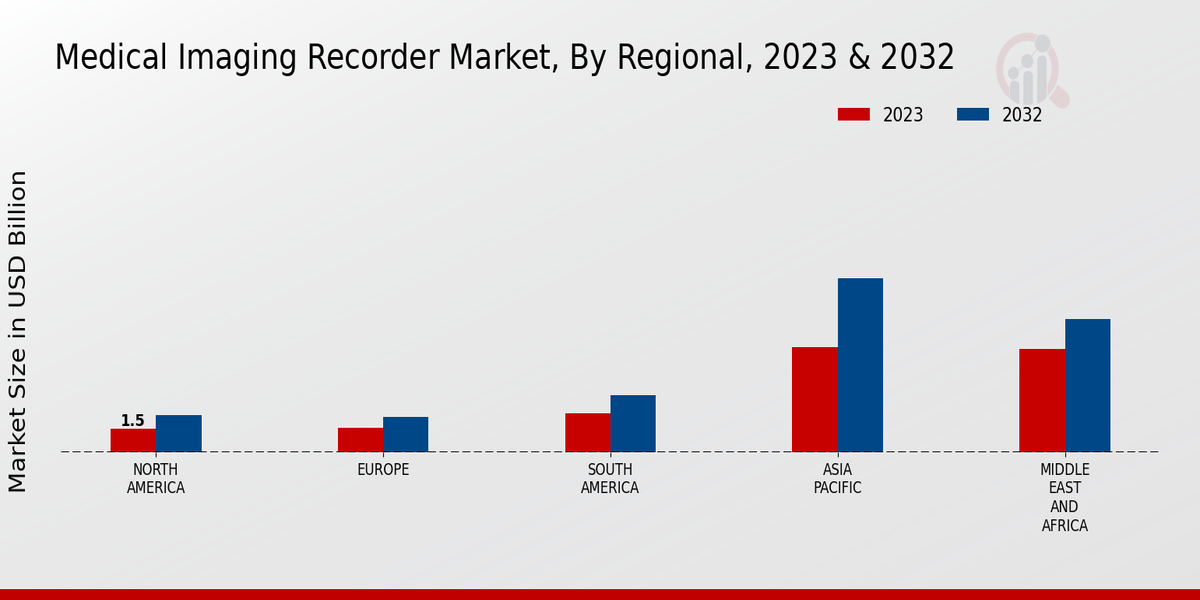Global Medical Imaging Recorder Market Overview
As per MRFR analysis, the Medical Imaging Recorder Market Size was estimated at 10.74 (USD Billion) in 2024. The Medical Imaging Recorder Market Industry is expected to grow from 11.21 (USD Billion) in 2025 to 16.49 (USD Billion) till 2034, at a CAGR (growth rate) is expected to be around 4.38% during the forecast period (2025 - 2034).
Key Medical Imaging Recorder Market Trends Highlighted
The medical imaging recorder market is poised for significant growth, driven by advancements in medical imaging technologies. Artificial intelligence (AI) integration enhances image quality and reduces interpretation time, bolstering market expansion.
The increasing prevalence of chronic diseases and the growing demand for minimally invasive procedures contribute to the market's expansion.
Furthermore, government initiatives to improve healthcare infrastructure in emerging economies create opportunities for market players.
Recent trends include the adoption of cloud-based solutions, which provide data storage and sharing capabilities, and the integration of advanced imaging modalities such as computed tomography (CT) and magnetic resonance imaging (MRI) recorders.
The market is expected to witness continued innovation and technological developments, shaping its future landscape.

Source: Primary Research, Secondary Research, Market Research Future Database and Analyst Review
Medical Imaging Recorder Market Drivers
Advancements in Medical Imaging Technology
One of the key drivers of growth for the Medical Imaging Recorder Market is the rapid advancement of medical imaging technology. There have been significant developments in new imaging techniques including digital radiography, computed tomography, magnetic resonance imaging, and ultrasound.
These technologies have increased the demand for medical imaging recorders due to their effectiveness in providing precise and accurate images. Specifically, advanced imaging techniques provide detailed images that allow physicians to make informed decisions regarding patient care.
It is anticipated that there will be increased demand for medical imaging recorders in the forthcoming years.
Increasing Prevalence of Chronic Diseases
Another major growth driver of the Medical Imaging Recorder Market is the increasing prevalence of chronic diseases, such as cancer, heart disease, and diabetes. Moreover, many of these diseases require regular imaging tests to monitor the disease’s progress and check for treatment results.
With the increasing number of populations developing chronic diseases, the demand for medical imaging recorders should also increase.
Government Initiatives and Regulations
Government initiatives and regulations are also contributing to the increasing growth of the Medical Imaging Recorder Market. Various governments are investing in healthcare facilities, and the laws by the governments promote the use of advanced technology, including medical imaging.
For example, in the U.S., the government’s Medicare program pays for outpatient imaging to patients, so most patients have access to these imaging services.
Medical Imaging Recorder Market Segment Insights
Medical Imaging Recorder Market Modality Insights
The Medical Imaging Recorder Market segmentation by Modality includes X-ray, Magnetic Resonance Imaging (MRI), Computed Tomography (CT), Ultrasound, and Nuclear Medicine. X-ray is the most widely used imaging modality, accounting for a significant share of the market.
Its low cost and wide availability make it a preferred choice for a variety of applications, including chest radiography, mammography, and dental imaging. Magnetic Resonance Imaging (MRI) provides highly detailed images of soft tissues and organs, making it valuable for diagnosing and monitoring conditions such as brain tumors, heart disease, and musculoskeletal injuries.
The global MRI market is expected to grow at a CAGR of 4.5% from 2025 to 2034, reaching a valuation of USD 8.2 billion by 2034. Computed Tomography (CT) uses X-rays and computer processing to generate cross-sectional images of the body.
It is commonly used for diagnosing and monitoring conditions such as cancer, heart disease, and lung disease. The global CT market is projected to grow at a CAGR of 4.8% from 2024 to 2032, reaching a valuation of USD 10.3 billion by 2032. Ultrasound uses sound waves to create images of internal organs and tissues.
It is commonly used for diagnosing and monitoring conditions such as pregnancy, heart disease, and abdominal pain. The global ultrasound market is expected to grow at a CAGR of 4.38% from 2025 to 2034, reaching a valuation of USD 16.69 billion by 2034.
Nuclear Medicine uses radioactive tracers to diagnose and monitor various diseases and conditions. It is commonly used for diagnosing and monitoring conditions such as cancer, heart disease, and thyroid disorders. The global nuclear medicine market is projected to grow at a CAGR of 4.9% from 2025 to 2034, reaching a valuation of USD 9.6 billion by 2034.

Source: Primary Research, Secondary Research, Market Research Future Database and Analyst Review
Medical Imaging Recorder Market Application Insights
The Medical Imaging Recorder Market is segregated in terms of Application into Diagnostic Imaging, Interventional Imaging, Surgical Imaging and Radiation Therapy Imaging. Diagnostic Imaging accounted for the largest share of the market in 2023, and it is anticipated to dominate the market throughout the forecast period.
This growth is attributed to the increasing demand for various medical imaging procedurs such as x-ray, CT, MRI and others. Interventional Imaging is expected to register highest CAGR during the forecast period due to increase in minimally invasive procedures and technological advancements in the imaging systems.
Additionally, the Surgical imaging subsegment is expected to grow at a significant rate due to rising number of surgical procedures and the advanced imaging techniques including the 3D imaging and augmented reality.
Radiation Therapy Imaging is expected to grow at a steady growth rate attributed to the increased prevalence of cancer and the development in radio therapy techniques.
Medical Imaging Recorder Market End User Insights
The Medical Imaging Recorder Market is segmented based on End Users into Hospitals, Ambulatory Surgery Centers, Diagnostic Imaging Centers, and Veterinary Clinics.
Among these segments, Hospitals held the largest market share of around 52% in 2023 and are expected to continue to dominate the market during the forecast period owing to the increasing number of hospitals and the growing demand for medical imaging services.
Ambulatory Surgery Centers are projected to witness the highest CAGR of 6.2% during the forecast period due to the increasing number of surgeries performed in these centers.
Veterinary Clinics are expected to hold a significant market share due to the rising awareness of pet health and the increasing adoption of medical imaging for animal diagnostics.
Medical Imaging Recorder Market Format Insights
The Medical Imaging Recorder Market is segmented based on Format into Film-based, Digital, and Cloud-based. The Digital segment is estimated to hold the largest market share in 2023, owing to the increasing adoption of digital technologies in healthcare.
The Cloud-based segment is expected to witness the highest growth rate during the forecast period due to the rising popularity of cloud computing in the healthcare industry.
However, the Film-based segment is expected to decline in the coming years as digital and cloud-based technologies become more prevalent.
Medical Imaging Recorder Market Technology Insights
The Medical Imaging Recorder Market is segmented by technology into thermal imaging, laser imaging, inkjet imaging, and solid-state imaging. The thermal imaging segment is expected to dominate the market in 2023, with a market share of over 50%.
This is due to the low cost and ease of use of thermal imaging technology. The laser imaging segment is expected to grow at a CAGR of over 6% during the forecast period, due to the increasing demand for high-resolution images. The inkjet imaging segment is expected to grow at a CAGR of over 5% during the forecast period, due to the increasing demand for portable and affordable medical imaging devices.
The solid-state imaging segment is expected to grow at a CAGR of over 4% during the forecast period, due to the increasing demand for high-quality images and the decreasing cost of solid state imaging technology.
Overall, the Medical Imaging Recorder Market is expected to grow at a CAGR of over 4% during the forecast period due to the increasing demand for medical imaging devices and the technological advancements in the field.
Medical Imaging Recorder Market Regional Insights
Regionally, North America and Europe are anticipated to dominate the market due to the presence of advanced healthcare infrastructure, high adoption of medical imaging technologies, and favorable reimbursement policies.
The Asia Pacific region is projected to witness significant growth owing to rising healthcare expenditure, increasing prevalence of chronic diseases, and government initiatives to improve healthcare access.
South America and MEA are expected to contribute moderately to the global market, driven by growing healthcare investments and expanding medical imaging capabilities.

Source: Primary Research, Secondary Research, Market Research Future Database and Analyst Review
Medical Imaging Recorder Market Key Players and Competitive Insights
Top companies in the Medical Imaging Recorder Market have embraced the dynamic changes that are taking place in the industry to guarantee greater performance and accuracy of the provided solutions. The presented players are actively developing new products and adopting innovative technologies to extend their regional presence and promote long-term outcomes.
The application of new solutions is one of the core factors that has determined the rapid growth of the sector and encouraged new companies to enter the market and contribute to its further development.
In this regard, the Medical Imaging Recorder Market Competitive Landscape is characterized by the active cooperation of market players to analyze strengths, weaknesses, opportunities, and threats and take maximum advantage of them.
The approaches supporting the production of new devices and extending the companies’ informational systems and controls ensure both patient safety and the ability of professionals to access more accurate data.
Canon Medical Systems Corporation is a leader in the Medical Imaging Recorder Market that is known for its innovative advances and technologies. The company focuses on numerous diagnostic imaging systems that are important for reducing the mortality rate in medical facilities.
Image processing software is also a promising sector that can guarantee better digital manipulation for better identification of health issues. Finally, the company’s Medical Imaging Recorders should be reviewed in detail to guarantee better data visualization.
Fujifilm Medical Systems USA, Inc. is a competitor of the previous company that offers similar solutions, including computed tomography scanners, magnetic resonance imaging systems, and Medical Imaging Recorders that differ in the provided solutions and image quality.
Key Companies in the Medical Imaging Recorder Market Include
- Shenzhen Mindray BioMedical Electronics Co., Ltd.
- Canon Medical Systems Corporation
- Samsung Electronics Co. Ltd.
- Fujifilm Holdings Corporation
- Mindray Medical International Limited
Medical Imaging Recorder Market Developments
The increasing adoption of advanced imaging technologies, such as digital radiography and computed tomography, is driving market growth. Additionally, the rising prevalence of chronic diseases and the aging population are contributing to the demand for medical imaging services.
Key market players include Fujifilm, Agfa-Gevaert, Canon Medical Systems, and Konica Minolta. Recent developments include the launch of new products, such as the FujiFilm DryPix 6000 Digital Radiography System and the Agfa HealthCare DR 800 Digital Radiography System. These advancements are expected to further fuel market growth in the coming years.
Medical Imaging Recorder Market Segmentation Insights
Medical Imaging Recorder Market Modality Outlook
- Magnetic Resonance Imaging (MRI)
Medical Imaging Recorder Market Application Outlook
- Radiation Therapy Imaging
Medical Imaging Recorder Market End User Outlook
- Ambulatory Surgery Centers
- Diagnostic Imaging Centers
Medical Imaging Recorder Market Format Outlook
Medical Imaging Recorder Market Technology Outlook
Medical Imaging Recorder Market Regional Outlook
| Report Attribute/Metric |
Details |
|
Market Size 2024
|
10.74 (USD Billion)
|
|
Market Size 2025
|
11.21 (USD Billion)
|
|
Market Size 2034
|
16.49 (USD Billion)
|
|
Compound Annual Growth Rate (CAGR)
|
4.38 % (2025 - 2034)
|
|
Report Coverage
|
Revenue Forecast, Competitive Landscape, Growth Factors, and Trends
|
|
Base Year
|
2024
|
|
Market Forecast Period
|
2025 - 2034
|
|
Historical Data
|
2020 - 2024
|
| Market Forecast Units |
USD Billion |
| Key Companies Profiled |
Carestream Health, Ziehm Imaging GmbH, Hologic, Inc., GE Healthcare, Hitachi, Ltd., Shenzhen Mindray BioMedical Electronics Co., Ltd., Canon Medical Systems Corporation, Samsung Electronics Co. Ltd., Barco NV, Fujifilm Holdings Corporation, Koninklijke Philips N.V., Mindray Medical International Limited, Trivitron Healthcare, Konica Minolta, Inc. |
| Segments Covered |
Modality, Application, End User, Format, Technology, Regional |
| Key Market Opportunities |
Growth of PACS Systems Artificial Intelligence in Radiology Demand for Compact and Portable Devices Increasing Focus on Remote Diagnostics Emerging Markets with Healthcare Infrastructure Development |
| Key Market Dynamics |
Technological advancements Rising demand for minimally invasive procedures Increasing prevalence of chronic diseases Growing geriatric population Government initiatives and regulations |
| Countries Covered |
North America, Europe, APAC, South America, MEA |
Frequently Asked Questions (FAQ):
The Global Medical Imaging Recorder Market reached a valuation of USD 10.74 billion in 2024.
The Global Medical Imaging Recorder Market is projected to grow at a CAGR of 4.38% from 2025 to 2034.
North America held the largest market share in the Global Medical Imaging Recorder Market in 2024.
The diagnostic imaging segment held the largest market share in the Global Medical Imaging Recorder Market in 2024.
Some of the key competitors in the Global Medical Imaging Recorder Market include Fujifilm, Sony, Canon, Toshiba, and Siemens Healthineers.
Some of the key trends driving the growth of the Global Medical Imaging Recorder Market include the increasing demand for high-quality medical images, the growing adoption of digital imaging technologies, and the rising prevalence of chronic diseases.
Some of the challenges facing the Global Medical Imaging Recorder Market include the high cost of medical imaging equipment, the lack of skilled professionals to operate the equipment, and the stringent regulatory requirements.
Technological advancements, such as the development of AI-powered imaging systems, are expected to have a significant impact on the Global Medical Imaging Recorder Market, leading to improved image quality and efficiency.
The regulatory landscape, including regulations on data privacy and patient safety, is expected to impact the Global Medical Imaging Recorder Market by influencing the adoption and use of medical imaging recorders.
Potential growth opportunities in the Global Medical Imaging Recorder Market include the expansion into emerging markets, the development of new applications, and the integration with other medical technologies.

















